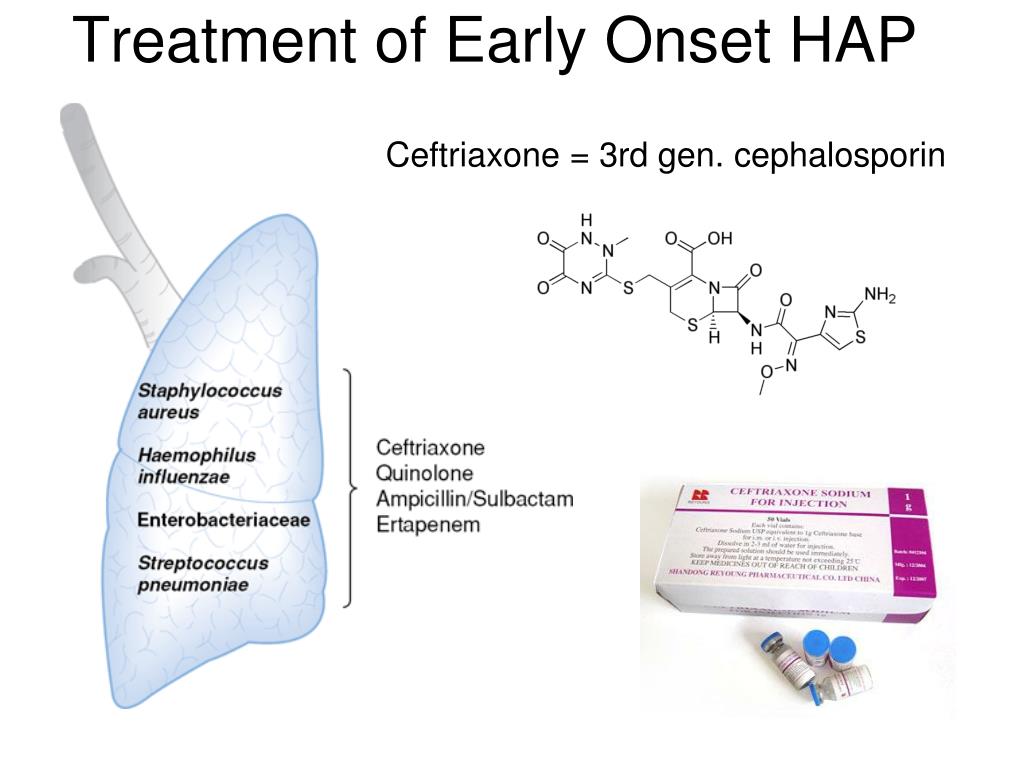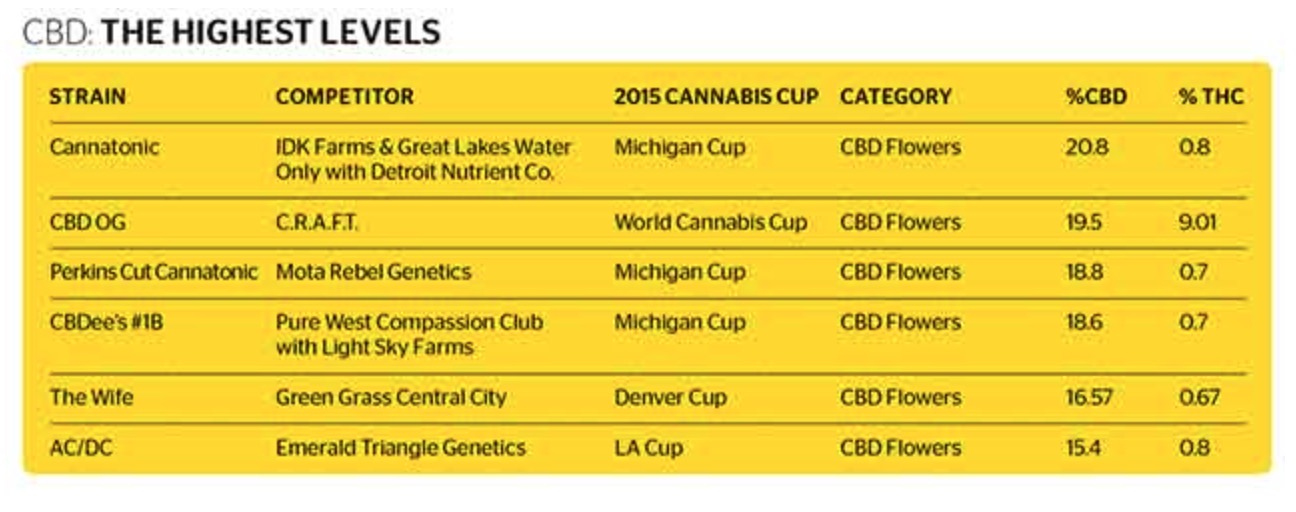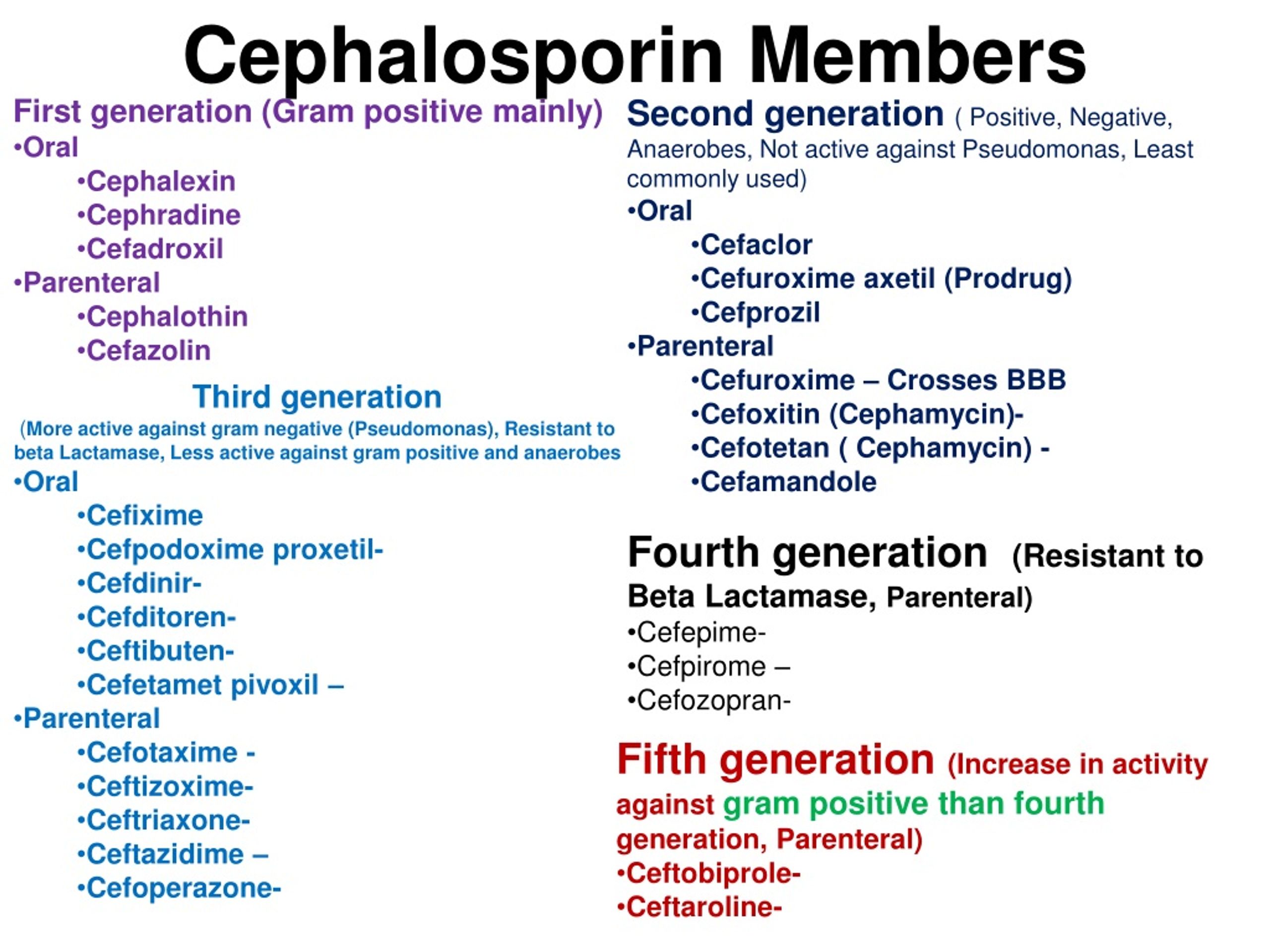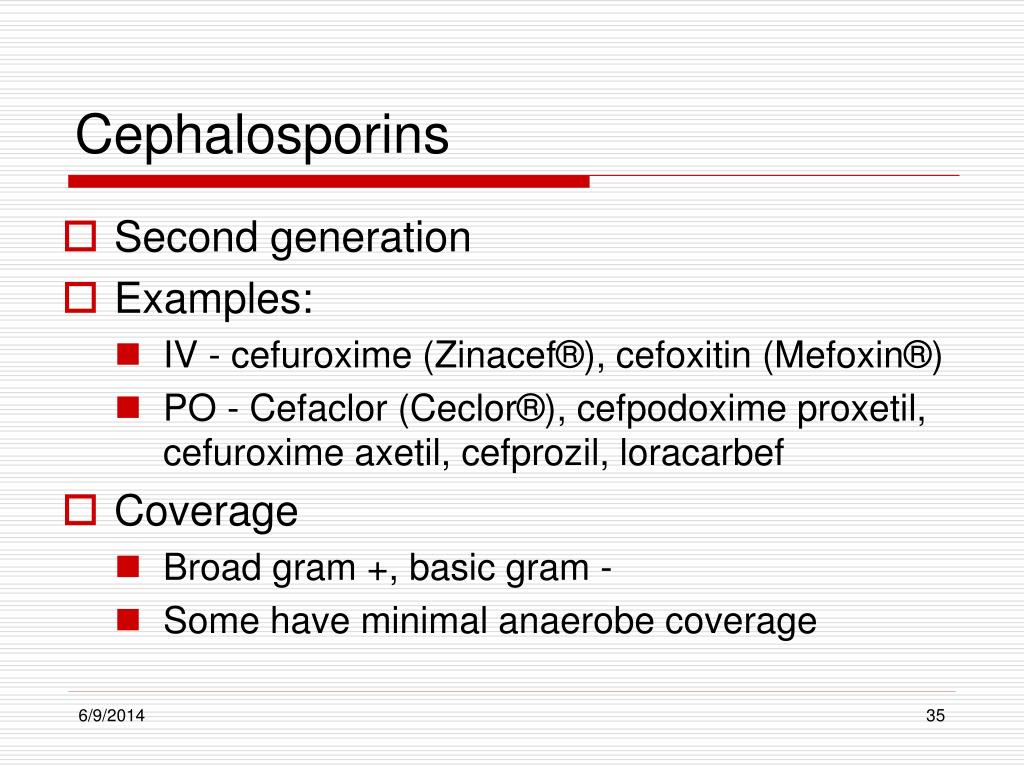Cephalosporins Brand Names: List of Cephalosporins + Uses, Types & Side Effects
What are cephalosporins used for? What are the differences between cephalosporins? Are cephalosporins safe?
Cephalosporins: An Overview
Cephalosporins are a large group of antibiotics derived from the mold Acremonium (previously called Cephalosporium). They are bactericidal, meaning they kill bacteria, and work in a similar way to penicillins. Cephalosporins bind to and block the activity of enzymes responsible for making peptidoglycan, an important component of the bacterial cell wall. They are considered broad-spectrum antibiotics, as they are effective against a wide range of bacteria.
Generations of Cephalosporins
After the first cephalosporin was discovered in 1945, scientists improved the structure of cephalosporins to make them more effective against a wider range of bacteria. This resulted in the development of five generations of cephalosporins, each differing slightly in their antibacterial spectrum and other properties.

First Generation Cephalosporins
First-generation cephalosporins have optimum activity against gram-positive bacteria such as staphylococci and streptococci, with little activity against gram-negative bacteria. Examples include cephalexin and cefadroxil, which can be given orally, and cefazolin, which can only be administered by injection (IV/IM).
Second Generation Cephalosporins
Second-generation cephalosporins are more active against gram-negative bacteria, with less activity against gram-positive bacteria.
Third Generation Cephalosporins
Third-generation cephalosporins followed the second-generation cephalosporins. No single third-generation cephalosporin treats all infectious disease scenarios. Cefotaxime and ceftizoxime (discontinued) offer the best gram-positive coverage, while ceftazidime and cefoperazone (discontinued) provide antipseudomonal coverage. Ceftriaxone has a long half-life, allowing for once-daily dosing, and may be used for the treatment of gonorrhea, pelvic inflammatory disease, and epididymo-orchitis. It is also an alternative to penicillins for suspected meningitis.

Fourth Generation Cephalosporins
Fourth-generation cephalosporins are structurally related to third-generation cephalosporins but possess an extra ammonium group, which allows them to rapidly penetrate through the outer membrane of gram-negative bacteria, enhancing their activity. They are also active against β-lactamase producing Enterobacteriaceae, which may inactivate third-generation cephalosporins. Cefepime is the only fourth-generation cephalosporin available in the United States, while cefpirome is available overseas.
Next (Fifth) Generation Cephalosporins
Ceftaroline is currently the only next-generation cephalosporin available in the United States. It is active against methicillin-resistant Staphylococcus aureus (MRSA) and gram-positive bacteria, while also retaining the activity of the later-generation cephalosporins and being effective against susceptible gram-negative bacteria.
Uses of Cephalosporins
Cephalosporins may be used to treat infections caused by susceptible bacteria, such as bone infections, ear infections (e.g., otitis media), skin infections, upper respiratory tract infections, and urinary tract infections.

Safety of Cephalosporins
Cephalosporins are generally safe, with low toxicity and good efficacy against susceptible bacteria. However, allergic reactions have been reported, with symptoms that may include a rash, hives (urticaria), swelling, or rarely, anaphylaxis. Up to 10% of people with a history of penicillin allergy will also be allergic to cephalosporins. Rarely, seizures have been reported with some cephalosporins, and the risk is greatest in those with kidney disease. Cephalosporins have also been associated with a reduced ability of the blood to clot, leading to prolonged bleeding times, particularly in those with kidney or liver disease, those who are nutritionally deprived, or those taking cephalosporins long-term or concurrently.
Conclusion
Cephalosporins are a large group of antibiotics with five generations, each with its own characteristics and uses. They are generally safe, with low toxicity, but can cause allergic reactions and other side effects, particularly in certain patient populations. Understanding the differences between the generations of cephalosporins and their appropriate uses is essential for healthcare providers when prescribing these medications.

List of Cephalosporins + Uses, Types & Side Effects
Cephalosporins are a large group of antibiotics derived from the mold Acremonium (previously called Cephalosporium). Cephalosporins are bactericidal (kill bacteria) and work in a similar way to penicillins. They bind to and block the activity of enzymes responsible for making peptidoglycan, an important component of the bacterial cell wall. They are called broad-spectrum antibiotics because they are effective against a wide range of bacteria.
After the first cephalosporin was discovered in 1945, scientists improved the structure of cephalosporins to make them more effective against a wider range of bacteria. Each time the structure changed, a new “generation” of cephalosporins were made. There are five generations of cephalosporins. Most cephalosporins start with cef, ceph, or kef. Note that this classification system is not used consistently from country to country.
What are cephalosporins used for?
Cephalosporins may be used to treat infections caused by susceptible bacteria, such as:
- Bone infections
- Ear infections (eg, otitis media)
- Skin infections
- Upper respiratory tract infections
- Urinary tract infections.

What are the differences between cephalosporins?
There are five “generations” of cephalosporins, with each generation differing slightly in their antibacterial spectrum (ie, how effective they are at killing certain types of bacteria). Within each generation, there are differences in terms of administration (such as oral or intravenous administration), absorption, excretion, and how long the activity of the cephalosporin lasts in the body.
First generation cephalosporins
First generation cephalosporins refer to the first group of cephalosporins discovered. Their optimum activity is against gram-positive bacteria such as staphylococci and streptococci. They have little activity against gram-negative bacteria.
Cephalexin and cefadroxil can be given by mouth, whereas cefazolin can only be given by injection (IV/IM). There are also differences with regards to how frequently the different first-generation cephalosporins need to be dosed.
Second generation cephalosporins
Second-generation cephalosporins are more active against gram-negative bacteria, with less activity against gram-positive bacteria.
Third generation cephalosporins
Third generation cephalosporins followed the second-generation cephalosporins. No single third-generation cephalosporin treats all infectious disease scenarios.
Cefotaxime and ceftizoxime (discontinued) offer the best gram-positive coverage out of all the third-generation agents; ceftazidime and cefoperazone (discontinued) are unique in that they provide antipseudomonal coverage.
Ceftriaxone has a long half-life which allows for once daily dosing and may be used for the treatment of gonorrhea, pelvic inflammatory disease, and epididymo-orchitis. It is also an alternative to penicillins for suspected meningitis.
All the third-generation cephalosporins except for cefoperazone (discontinued) penetrate cerebrospinal fluid.
Fourth generation cephalosporins
Fourth generation cephalosporins are structurally related to third-generation cephalosporins but possess an extra ammonium group, which allows them to rapidly penetrate through the outer membrane of gram-negative bacteria, enhancing their activity. They are also active against β-lactamase producing Enterobacteriaceae which may inactivate third-generation cephalosporins.
They are also active against β-lactamase producing Enterobacteriaceae which may inactivate third-generation cephalosporins.
Some fourth-generation cephalosporins have excellent activity against gram-positive bacteria such as methicillin-susceptible staphylococci, penicillin-resistant pneumococci, and viridans group streptococci.
Cefepime is the only fourth generation cephalosporin available in the United States. Cefpirome is available overseas.
Next (fifth) generation cephalosporins
Ceftaroline is currently the only next-generation cephalosporin available in the United States. It is active against methicillin-resistant Staphylococcus aureus (MRSA) and gram-positive bacteria. It also retains the activity of the later-generation cephalosporins and is effective against susceptible gram-negative bacteria.
Are cephalosporins safe?
Cephalosporins are generally safe, with low toxicity and good efficacy against susceptible bacteria.
Allergic reactions have been reported with cephalosporins and symptoms may include a rash, hives (urticaria), swelling, or rarely, anaphylaxis. Up to 10% of people with a history of penicillin allergy will also be allergic to cephalosporins.
Rarely, seizures have been reported with some cephalosporins; the risk is greatest in those with kidney disease.
Cephalosporins have also been associated with a reduced ability of the blood to clot leading to prolonged bleeding times. People with kidney or liver disease, nutritionally deprived, taking cephalosporins long-term, or concurrently receiving anticoagulant therapy are more at risk.
For a complete list of severe side effects, please refer to the individual drug monographs.
What are the side effects of cephalosporins?
Cephalosporins generally cause few side effects. The most common side effects reported include abdominal pain, diarrhea, dyspepsia, headache, gastritis, and nausea and vomiting. Transient liver problems have also been reported.
Rarely, some people may develop a super-infection due to overgrowth of a naturally occurring bacterium called Clostridium difficile, following use of any antibiotic, including cephalosporins. Symptoms may include severe diarrhea.
Uncommonly, an overgrowth of the yeast, Candida albicans, may occur following cephalosporin use, resulting in the symptoms of thrush.
For a complete list of side effects, please refer to the individual drug monographs.
Always consult your healthcare provider to ensure the information displayed on this page applies to your personal circumstances.
What are Cephalosporins? Uses, Warnings, Side Effects, and More
Common Questions & Answers
What drugs are cephalosporins?
Cephalosporins are a large group of beta-lactam antibiotics. These drugs are used to treat a wide variety of bacterial infections. There are five generations of cephalosporins, grouped according to their range of coverage against bacteria and when the drugs were developed.
What are examples of cephalosporins?
Examples of cephalosporins include first-generation drugs cefazolin and cephalexin; second-generation drugs cefuroxime and cefoxitin; third-generation drugs ceftriaxone and ceftazidime; fourth-generation drug cefepime; and fifth-generation drug ceftaroline.
Is a cephalosporin a penicillin?
Cephalosporins are similar to penicillins on a molecular level, and as a result, they might lead to an allergic reaction in people who are allergic to penicillins. If your penicillin allergy is not severe, you may still be able to take cephalosporins, but probably not first- or second-generation drugs.
What are the most common cephalosporins?
The first-generation cephalosporins (such as cefazolin and cephalexin) are commonly used to treat skin and soft tissue infections. Second-generation cephalosporins, including cefaclor, cefprozil, loracarbef, and cefpodoxime, are commonly used to treat sinus, lung, and ear infections.
What are the five generations of cephalosporins?
First and second generation cephalosporins (such as cefazolin and cefuroxime) treat skin and soft tissue infections. Cefuroxime also treats respiratory infections and UTIs. Third-generation cephalosporins (ceftriaxone and ceftazidime) are typically for serious infections. Fourth-generation cefepime treats staphylococcal infections. Fifth-generation ceftaroline is effective against MRSA and pneumonia.
Cefuroxime also treats respiratory infections and UTIs. Third-generation cephalosporins (ceftriaxone and ceftazidime) are typically for serious infections. Fourth-generation cefepime treats staphylococcal infections. Fifth-generation ceftaroline is effective against MRSA and pneumonia.
Because of their long history of development, there are numerous cephalosporins on the market. According to the Nelson Textbook of Pediatrics, the five generations of cephalosporins break down as follows:
- First-generation cephalosporins are commonly used to treat skin and soft tissue infections. Examples include cefazolin and cephalexin. Doctors also use these drugs to treat bone, respiratory, urinary, genital, biliary tract, ear, and bloodstream infections, per StatPearls.
- Second-generation cephalosporins are used to treat respiratory tract infections, UTIs, skin and soft tissue infections, and Lyme disease. Examples include cefuroxime and cefoxitin. Other second-generation cephalosporins (cefaclor, cefprozil, loracarbef, cefpodoxime) are commonly used to treat sinus, lung, and ear infections.

- Third-generation cephalosporins are typically used for serious infections, including meningitis and sepsis. Examples include ceftriaxone and ceftazidime. Ceftriaxone is also used to treat gonorrhea and Lyme disease, per StatPearls.
- A fourth-generation cephalosporin called cefepime is used to treat staphylococcal infections.
- A fifth-generation cephalosporin called ceftaroline is effective against MRSA (methicillin-resistant Staphylococcus aureus) and community-acquired pneumonia.
Precautions and Warnings
People who are allergic to cephalosporins, or any inactive ingredients found in these drugs, shouldn’t take them.
Cephalosporins share a molecular similarity with penicillins, and so might lead to an allergic reaction in people who are allergic to penicillins. Depending on the severity of your penicillin allergy, you may still be able to take cephalosporins, but most likely not first- or second-generation drugs, notes StatPearls.
You should also avoid cephalosporins if you’ve had an anaphylactic reaction to other beta-lactams.
The third-generation cephalosporin ceftriaxone is contraindicated in some newborns, because it could increase the risk of jaundice.
Make sure your doctor or pharmacist is monitoring your kidney function when you are taking cephalosporins, because that could potentially warrant a change in the dose or dosing frequency of your medication.
An overdose of the fourth-generation cephalosporin cefepime can lead to seizures and encephalopathy (brain disease). If you have a history of seizures, especially with poor kidney function, use caution when taking cephalosporins.
As with all antibiotics, it’s important that you finish the entire course you were prescribed — even if you feel better. This is the only way to ensure that the infection is completely gone. Otherwise, the infection could return and be much more difficult to treat the second time around.
What Are Antacids? Uses, Warnings, Side Effects, and More
For occasional heartburn, indigestion, or acid reflux, antacids may help manage symptoms of pain and discomfort by neutralizing stomach acid.
By Frieda Wiley, PharmD, RPh
What Are Sulfonamides? Uses, Warnings, Side Effects, and More
Sulfonamides are a group of medicines used to treat bacterial infections, urinary tract infections (UTIs), and other conditions.
By Julie Lynn Marks
What Is a Diuretic? Uses, Warnings, Side Effects, and More
A diuretic, a type of drug also known as “water pills,” helps rid the body of extra water and lower blood pressure.
By Frieda Wiley, PharmD, RPh
What Are COX-2 Inhibitors?
COX-2 Inhibitors are a type of nonsteroidal anti-inflammatory drug (NSAIDs) that treat inflammatory pain.
By Erin Archer Kelser, RN
What Are Aromatase Inhibitors?
Aromatase inhibitors are a class of drugs that reduce the production of estrogen in the body.
By Erin Archer Kelser, RN
What Are Sedatives?
Sedatives are a category of drugs that slow brain activity. Also known as tranquilizers or depressants, sedatives have a calming effect and can also induce…
By Erin Archer Kelser, RN
What Are Calcium Channel Blockers?
Calcium channel blockers are commonly prescribed medications for high blood pressure. The medications reduce blood pressure by helping blood vessels to…
By Diana Rodriguez
What Are Tricyclic Antidepressants?
Tricyclic antidepressants, or TCAs, are a class of drugs that has been used for decades to treat depression, anxiety, and certain kinds of pain.
By Frieda Wiley, PharmD, RPh
Cephalosporins: pharmacological group
Depending on the characteristics of the antimicrobial spectrum, 5 generations of cephalosporins are isolated.
First generation cephalosporins: parenteral – cefazolin, oral – cephalexin.
II generation cephalosporins: parenteral – cefuroxime, oral – cefuroxime axetil, cefaclor.
III generation cephalosporins: parenteral – cefotaxime, ceftriaxone, cefoperazone, cefoperazone / sulbactam, ceftazidime, oral – cefditoren, cefixime, cefpodoxime, ceftibuten.
IV generation cephalosporins: parenteral – cefepime, cefpirome.
V generation cephalosporins (anti- MRSA -cephems): parenteral – ceftaroline, ceftobiprole.
I generation cephalosporins have predominant activity against gram-positive cocci – staphylococci and streptococci. Gram-negative bacteria are resistant, with the exception of some community-acquired strains E. coli and P. mirabilis. Used for infections of the skin and soft tissues, bones and joints, for perioperative prophylaxis. As an alternative means, it is used for endocarditis and sepsis caused by methicillin-sensitive staphylococci and viridescent streptococci. Cefazolin does not penetrate well through the BBB. Excreted mainly in the urine, T 1/2 – 2 hours, administered 2-3 times a day. Cephalexin has a high oral bioavailability. The main indications for the use of cephalexin: streptococcal pharyngitis, streptococcal and staphylococcal uncomplicated community-acquired infections of the skin and soft tissues.
Cefazolin does not penetrate well through the BBB. Excreted mainly in the urine, T 1/2 – 2 hours, administered 2-3 times a day. Cephalexin has a high oral bioavailability. The main indications for the use of cephalexin: streptococcal pharyngitis, streptococcal and staphylococcal uncomplicated community-acquired infections of the skin and soft tissues.
II generation cephalosporins, having activity similar to the first generation cephalosporins against gram-positive cocci, surpass them in their effect on gram-negative bacteria, primarily H. influenzae. Well distributed (except for the central nervous system), excreted mainly by the kidneys, have close T 1/2 (about 1 hour). Used for the treatment of community-acquired infections, for perioperative prophylaxis.
III generation parenteral cephalosporins have a high natural activity against gram-negative bacteria (family Enterobacteriaceae, H. influenzae, N. gonorrhoeae, N. meningitidis), are not inactivated by many β-lactamases. Degraded by extended spectrum β-lactamases and class C β-lactamases (AmpC). Ceftazidime and cefoperazone are active against P. aeruginosa. In terms of activity against staphylococci, they are significantly inferior to drugs of the first and second generations, but against streptococci and pneumococci, cefotaxime and ceftriaxone are superior to other cephalosporins and act on many penicillin-resistant strains. Ceftazidime is practically inactive against Gram-positive bacteria. All drugs of this group are well distributed in the body, penetrate (except for cefoperazone) through the BBB and can be used to treat infections of the central nervous system. Cefotaxime and ceftazidime are excreted by the kidneys, while cefoperazone and ceftriaxone are excreted by the kidneys and liver. All III generation cephalosporins have similar T 1/2 (1.2-2 hours), except for ceftriaxone (about 7 hours). It is used to treat severe community-acquired and nosocomial infections caused by gram-negative microorganisms.
Degraded by extended spectrum β-lactamases and class C β-lactamases (AmpC). Ceftazidime and cefoperazone are active against P. aeruginosa. In terms of activity against staphylococci, they are significantly inferior to drugs of the first and second generations, but against streptococci and pneumococci, cefotaxime and ceftriaxone are superior to other cephalosporins and act on many penicillin-resistant strains. Ceftazidime is practically inactive against Gram-positive bacteria. All drugs of this group are well distributed in the body, penetrate (except for cefoperazone) through the BBB and can be used to treat infections of the central nervous system. Cefotaxime and ceftazidime are excreted by the kidneys, while cefoperazone and ceftriaxone are excreted by the kidneys and liver. All III generation cephalosporins have similar T 1/2 (1.2-2 hours), except for ceftriaxone (about 7 hours). It is used to treat severe community-acquired and nosocomial infections caused by gram-negative microorganisms. Cefoperazone / sulbactam, a combination of a third-generation cephalosporin with the β-lactamase inhibitor sulbactam, has an extended spectrum of activity compared to cephalosporins, including anaerobes and many nosocomial bacterial strains, incl. most strains producing extended spectrum β-lactamase.
Cefoperazone / sulbactam, a combination of a third-generation cephalosporin with the β-lactamase inhibitor sulbactam, has an extended spectrum of activity compared to cephalosporins, including anaerobes and many nosocomial bacterial strains, incl. most strains producing extended spectrum β-lactamase.
Third-generation oral cephalosporins cefixime and ceftibuten are active against Enterobacteria and Haemophilus influenzae, but are not very active against Gram-positive organisms, including pneumococci, streptococci, and staphylococci; therefore, they should not be used in Gram-positive infections, especially community-acquired pneumonia. Cefditoren, unlike cefixime and ceftibuten, has high activity against staphylococci and streptococci (including pneumococci), and therefore does not have the above limitations.
IV generation cephalosporins are characterized by high activity against Gram-negative bacteria, including P. aeruginosa, and increased activity against Gram-positive flora compared to III generation drugs (ceftazidime). Active against some nosocomial strains Enterobacteriaceae, resistant to III generation cephalosporins. Destroyed by extended spectrum β-lactamases, but resistant to class C β-lactamases. Used to treat severe nosocomial infections, incl. in the intensive care unit and in neutropenic patients. Cefpirome is inferior to cefepime in activity against most pathogens.
Active against some nosocomial strains Enterobacteriaceae, resistant to III generation cephalosporins. Destroyed by extended spectrum β-lactamases, but resistant to class C β-lactamases. Used to treat severe nosocomial infections, incl. in the intensive care unit and in neutropenic patients. Cefpirome is inferior to cefepime in activity against most pathogens.
Fifth generation cephalosporins (anti- MRSA -cephems) include parenteral preparations ceftaroline and ceftobiprole only. The main distinguishing feature of the fifth generation cephalosporins is the highest in vitro activity among β-lactams against gram-positive bacteria, including most strains of MRSA . The activity of ceftaroline and ceftobiprole against gram-negative bacteria is generally equivalent to that of cefotaxime and ceftriaxone.
The most common side effects are allergic reactions. Approximately 10% of patients with hypersensitivity to penicillin have cross-allergic reactions to cephalosporins of the first generation.


